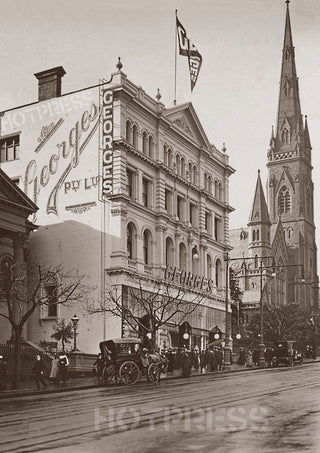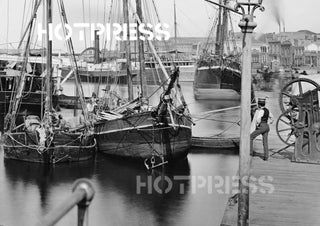1910c Georges Building Collins Street
Description
A look at how the well-to-do shopped in Melbourne at "Georges" in the 1900s. This trend-setting multi-level department store's motto was "Quod facimus, Valde facimus" (What we do, We do well) and exemplified a philosophy of exclusive goods and meticulous service.
The "Georges" building was originally built for the Equitable Co-operative Society in 1883. Designed by architects John Grainger and Charles D'Ebro and built on land owned by Scots' Church, the building was constructed in classical revival style in 1883 by David Mitchell. (See it as it was before it was "Georges".)
The Equitable Co-operative Society soon went bankrupt, and land boom speculator and politician B.J. Fink had the building extended in 1887 through to Little Collins Street, the alterations designed by architect David Christopher Askew. Georges (founded by brothers William and Alfred George in 1880) moved in after a fire forced them to move from their original site further west in Collins Street in 1889, with "Georges" at 162 Collins Street soon becoming Melbourne's most exclusive shopping address.
Cox Brothers took over Georges from 1960-66, with David Jones Ltd buying the business in 1981. Sadly, Georges ceased trading after 115 years in 1995. Fortunately, the building survives and now houses a number of smaller specialist retailers. However, the shopping experience that once was "Georges" will never be seen again.
All text © HotPress
Photographer unknown.
Notes from the State Library tell us that this image is of a "Four storey Edwardian building, built in Renaissance Revival style with central pediment at roof line. Flag pole with Georges pennant on roof. Looking south name of building painted on side wall: Georges Pty Ltd. ; Spire of Scots Church. Horse drawn carriages in front of store."
This is a digitally retouched reproduction of the original held by the State Library of Victoria. All prints are reproduced without the HOTPRESS watermarks.
Our team of conservators have worked on a high resolution digital image in order to remove blemishes and artifacts such as stains, mould, scratches and damage caused by the handling of the original. We strive to provide authentic representations of the original work that are suitable for enlargements that retain the tones and character of the original.
Description
A look at how the well-to-do shopped in Melbourne at "Georges" in the 1900s. This trend-setting multi-level department store's motto was "Quod facimus, Valde facimus" (What we do, We do well) and exemplified a philosophy of exclusive goods and meticulous service.
The "Georges" building was originally built for the Equitable Co-operative Society in 1883. Designed by architects John Grainger and Charles D'Ebro and built on land owned by Scots' Church, the building was constructed in classical revival style in 1883 by David Mitchell. (See it as it was before it was "Georges".)
The Equitable Co-operative Society soon went bankrupt, and land boom speculator and politician B.J. Fink had the building extended in 1887 through to Little Collins Street, the alterations designed by architect David Christopher Askew. Georges (founded by brothers William and Alfred George in 1880) moved in after a fire forced them to move from their original site further west in Collins Street in 1889, with "Georges" at 162 Collins Street soon becoming Melbourne's most exclusive shopping address.
Cox Brothers took over Georges from 1960-66, with David Jones Ltd buying the business in 1981. Sadly, Georges ceased trading after 115 years in 1995. Fortunately, the building survives and now houses a number of smaller specialist retailers. However, the shopping experience that once was "Georges" will never be seen again.
All text © HotPress
Photographer unknown.
Notes from the State Library tell us that this image is of a "Four storey Edwardian building, built in Renaissance Revival style with central pediment at roof line. Flag pole with Georges pennant on roof. Looking south name of building painted on side wall: Georges Pty Ltd. ; Spire of Scots Church. Horse drawn carriages in front of store."
This is a digitally retouched reproduction of the original held by the State Library of Victoria. All prints are reproduced without the HOTPRESS watermarks.
Our team of conservators have worked on a high resolution digital image in order to remove blemishes and artifacts such as stains, mould, scratches and damage caused by the handling of the original. We strive to provide authentic representations of the original work that are suitable for enlargements that retain the tones and character of the original.


